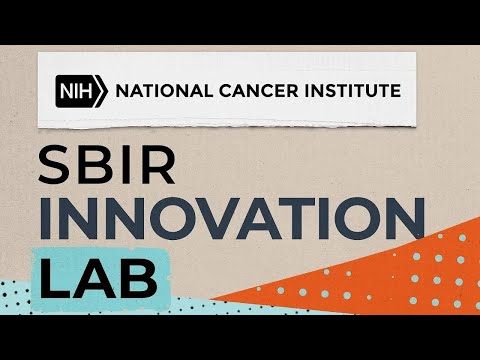Listen
Listen on the YouTube channel.
Episode Guests
Monique Pond, Ph.D.
Monique Pond, Ph.D., is a Team Leader and Program Director at the Small Business Innovation Research (SBIR) Development Center at the National Cancer Institute (NCI). She manages a portfolio of grants and contracts to small businesses developing novel cancer therapeutics, digital health technologies, and therapeutic devices.
Dr. Pond leads the Connecting Awardees with Regulatory Experts (CARE) program and other collaborative initiatives with the U.S. Food and Drug Administration (FDA) to assist small businesses in navigating the regulatory pathway for their technology. She initially joined the NCI SBIR Development Center in 2018 as a Science & Technology Policy Fellow with the American Association for the Advancement of Science.
Jonathan Franca-Koh, Ph.D.
Jonathan Franca-Koh, Ph.D., is a Team Leader and Program Director at the National Cancer Institute's Small Business Innovation Research (SBIR) Development Center. Dr. Franca-Koh manages SBIR & STTR grants and contracts with a focus on cancer therapeutics and novel tools for research and drug discovery. He provides oversight throughout the award period and mentors applicants and awardees in developing their technology goals and commercialization strategy. Additionally, he plays an active role in several center initiatives, including recent investor forums, workshops, targeted funding opportunities, and represents the NCI on the trans-NIH REACH program. Prior to joining the SBIR Development Center, Dr. Franca-Koh was a Program Director at the NCI Division of Cancer Biology and Center for Strategic Scientific Initiatives, overseeing the Physical Sciences-Oncology Centers (PS-OC) program, a network of interdisciplinary centers that brought together physical scientists and cancer biologists. Dr. Franca-Koh received his PhD in Cell and Molecular Biology from the University of London’s Institute of Cancer Research in 2003, and completed post-doctoral research at Johns Hopkins University and the J. Craig Venter Institute. In 2014, he completed his M.B.A from Johns Hopkins University, focusing on finance and healthcare innovation.
Articles referenced in this episode:
- SAM (System for Award Management)
- eRA Commons
- Grants.gov
- SBA (Small Business Administration)
- NIH SEED Small Business Funding
Visit our website, sbir.cancer.gov, for the latest funding opportunities and commercialization resources to support your journey from lab to market.
Episode Transcript
[Music]
MONIQUE POND: Hello everyone and welcome to Innovation Lab, your go-to resource for all things biotech startups, brought to you by the National Cancer Institute’s Small Business Innovation Research or SBIR Development Center.
Our podcast hosts interviews with successful entrepreneurs and provides resources for small businesses looking to take their cutting-edge cancer solutions from lab to market. I'm Dr. Monique Pond, a Program Director and team lead here at NCI SBIR and I'll be today's host.
Today, we'll discuss a typical timeline for applicants from submitting their SBIR/STTR application to hopefully successfully receiving an award. Once again, we're joined by my fellow program Director and Team Leader at the NCIS SBR Development Center, Dr. Jonathan Franca-Koh. Welcome back, Johnny.
JONATHAN FRANCA-KOH: Thanks, Monique, happy to be here.
MONIQUE POND: So for people listening in today, before applying for SBIR/STTR funding, what does an applicant need to do?
JONATHAN FRANCA-KOH: As we discussed in the previous podcast episode, one of the first things you should do is contact a program director in our office and we'd be happy to walk through the process with you.
One of the first things you need to do is complete your company registrations. Here, there are four registrations that need to be completed. These are the SAM or System for Award Management, this is the electronic platform that is required for a company to do business with the US government.
Second is ERA Commons, this is the electronic system required to do business with the NIH. And then the other two are Grants.gov, which is a platform you will use to submit grant applications. And then finally, register with the SBA, Small Business Administration, and this is required for companies to participate in SBIR and STTR funding programs.
So while the number of applications has gone down, it still needs to be taken care of well in advance of submitting your application, because it can take six weeks or more to complete these registration steps. And there's also the order in which you do so is important.
First up is System for Award Management, SAM, you need to complete your SAM registration in order to then go on and complete the other registrations. This can take three weeks or sometimes longer to do an initial registration, and this is one that requires yearly renewal as well.
So even if you've received a SAM registration in the past, make sure it's current, if you are thinking of submitting an application in the near future.
MONIQUE POND: That's a good point, Johnny. And I would say for those who have happily been awarded, that's something to keep in mind, too, for the future that if you have a multi-year award, you want to make sure that you're keeping up with that SAM registration so you can progress to the next year of funding. So that's where companies and entrepreneurs should start, SAM registration, OK.
JONATHAN FRANCA-KOH: Yeah. And then you complete your SAM registration and you receive what's called a Unique Entity Identifier or UEI. Now, once your SAM registration is approved and active, next step is to register with Grants.gov.
Grants.gov is the platform you will use to submit your application. Once you have your SAM registration, you can then go ahead and register for that, and this takes about one business day or more, it can depend a little bit, but not, not as long as SAM.
MONIQUE POND: So is this the same Grants.gov where people can go if they're interested in just kind of doing a federal-wide search for different grant funding opportunities?
JONATHAN FRANCA-KOH: Yes. So the Grants.gov is not an NIH specific platform, it's a federal-wide portal which you can use to look for funding opportunities as well as apply for federal grant funding.
Next up, once you've received your unique identifier, UEI number from SAM, you may then go ahead and apply for your ERA Commons. You, as an individual, may already have an ERA ID and account, but your company needs its own account to do business with the NIH.
And registering for a new company in ERA Commons can take about two weeks or more, so make sure you do that ahead of time.
The ERA Commons system allows you to submit and receive information regarding your application, and your ERA Commons credentials are also used to access what's called the Assist System, which is NIH’s online system that can help streamline your grant submission.
MONIQUE POND: So with an ERA Commons account, is there just one person for each company that's associated with the account? Or could there be multiple people that have different roles and still have the same ERA Commons ID?
JONATHAN FRANCA-KOH: Excellent question. So with the new company registration, you need to identify a company signing official and this will be the person that has the authority to represent the company, the institution in grants administration matters.
It's also important to remember that you may have your unique ERA Commons ID, but that same ID can be used to access different roles and also different affiliations, so you shouldn't have to create different ERA Commons IDs for yourself, as an individual, over the course of your career, you stick with the same one, but you manage that account by adding either different roles for that account and different affiliations.
So perhaps you have both a university and an affiliation with the company, you can make sure to add both of those roles to your account. You need to be affiliated with the institution that you're representing to be on their application.
MONIQUE POND: And you know, I just want to add too, as sometimes, depending on the company structure and, and how busy, you know, the PI is, sometimes the PI is the signing official, but you could also have for an example an optional account administrator that is -- has access and is a, a signing official for that ERA Commons and company account.
JONATHAN FRANCA-KOH: Yes. And then last but not least, the final registration is with the Small Business Administration, SBA Company Registry. Once you complete the SAM registration, you can go ahead and do this, and this takes one to two business days to complete. And this registration is required in order for a company to participate in SBIR and STTR funding programs.
MONIQUE POND: So it sounds like for a company interested in applying to an upcoming due date, starting the earlier the better, right, with these registrations, since they can take several, sounds like several weeks, maybe even a couple months, to get through all four.
JONATHAN FRANCA-KOH: Absolutely. And they need to be completed to submit the application.
MONIQUE POND: Thanks, Johnny. That's been a great summary of the four registrations that are required for companies. And for those who want more details or, or want some links to go ahead and get those started, you can go to seed.nih.gov and find links to all four of the registrations that, that Johnny just mentioned.
So now, the company has completed the registrations, they've talked to a program director, developed a great specific aims page, submitted their grant application. So what happens next, Johnny?
JONATHAN FRANCA-KOH: Once you've submitted your application, hopefully it all went smoothly and you didn't receive any messages indicating a problem with the application, in which case you can sit tight and wait for the review to take place.
However, it's quite common that you will receive an e-mail indicating that there either are errors or warnings associated with your application. In the case of a warning, that is something the system has identified that it wants you to double-check or take a look at.
If you receive an error warning on your application, the application will still be processed, however, you should take steps to identify what these warnings are and make sure that everything's fine. If you receive an error message, this is an indication that your application will not be processed as submitted and so you will need to take steps to correct that error.
Now, as program directors, we're not able to help you correct most of these errors. You need to contact either the ERA or Grants.gov Help Desk, which you can find on the websites, and here, they're excellent technical support to help you both understand what the problem is and correct the issue.
MONIQUE POND: Yes, I think you know within the, the two or three days right before due date, those help desk, as you can imagine, are quite, quite busy, but, you know, if you're able to start the application say a week before the deadline, you know, and you encounter some of these errors that Johnny mentioned, I think, you know, that can, that can be a great time to reach out to the help desk and someone will be able to walk you through the, the solutions to them.
JONATHAN FRANCA-KOH: Yes, that's another reason we always recommend applying early, because you never know what, what to expect.
MONIQUE POND: All right, so let's say a company now has their application error-free through the system, and about how long should they expect timeline wise before the review will take place?
JONATHAN FRANCA-KOH: Once you've applied and the application has been accepted, it will next be sent for review, and the review will take place about two months after the application is submitted. Following review, you'll receive a score. This will either be a number indicating how well the application is scored, or potentially it could receive what's called a non-discussed score. That means unfortunately your application in this case was considered to be in the lower half of applications.
However, this is just your initial, um, idea of how well the application did. You really want to know the details, what reviewers thought, what their comments were, what they thought the strengths and weaknesses of the application were, and you'll get this in a document called the Summary Statement, which is released a couple of weeks after review has taken place, and this will be a summary of the reviewer comments, as well as a synopsis of the discussion that occurred at review.
And once you receive the Summary Statement, this is actually the best time to then follow up with your assigned program director to discuss what the chances of success are for funding the application and if, if not, what are the next steps in terms of potential resubmitting? What -- How would you go about addressing the, the weaknesses that have been identified?
MONIQUE POND: And I just want to add that, as far as the full Summary Statement with the comments that Johnny mentioned, that can be up to 30 days after that review meeting before that full Summary Statement is available.
But, you know, once a company or an applicant can see that in their ERA Commons account and has access to that full Summary Statement, then that assigned program director, on the first page in the upper left hand corner, you'll have that contact information and that program director will have access to those same comments. So a great time to reach out, we're always happy to set up a meeting and, and talk about your Summary Statement.
So I think we've gone through, you know, getting started with the company registrations, you know, first steps to applying for the, the grant, and kind of a general timeline for review and then follow up, hopefully, you know, with the successful score and discussing with the program director, either potential funding opportunity or, you know, as you mentioned resubmission.
Thanks again, Johnny, for speaking with us today, always, always a pleasure.
JONATHAN FRANCA-KOH: Thanks for having me, Monique. Glad to be back.
MONIQUE POND: As always, don't forget to check out our website, sbir.cancer.gov, for the latest funding opportunities and commercialization resources to support your journey from lab to market.
This was Monique Pond from NCI SBIR. Please join us again for the next installment of NCI SBIR Innovation Lab, and subscribe today, wherever you listen.
If you have questions about cancer or comments about this podcast, you can e-mail us at nciinfo@nih.gov or call at 800-422-6237, and please be sure to mention Innovation Lab in your query.
We are a production of the US Department of Health and Human Services, National Institutes of Health, National Cancer Institute. Thanks for listening.


